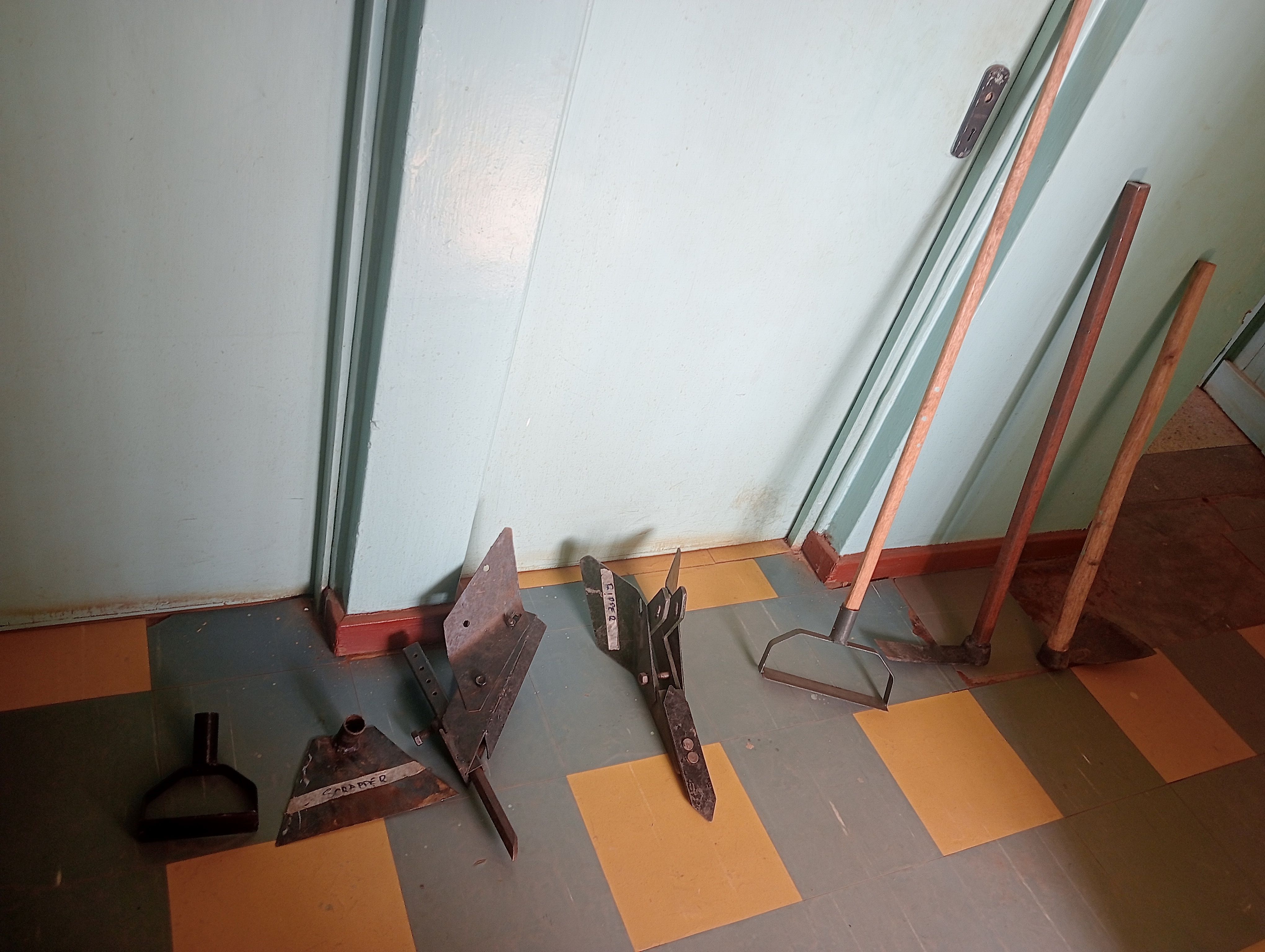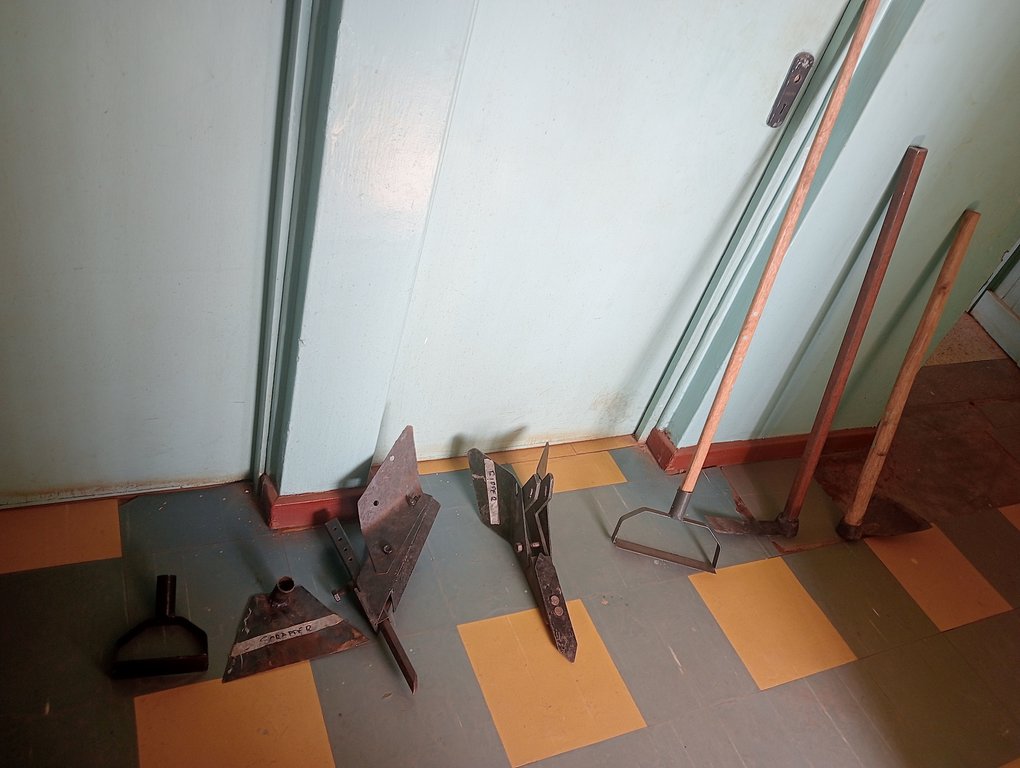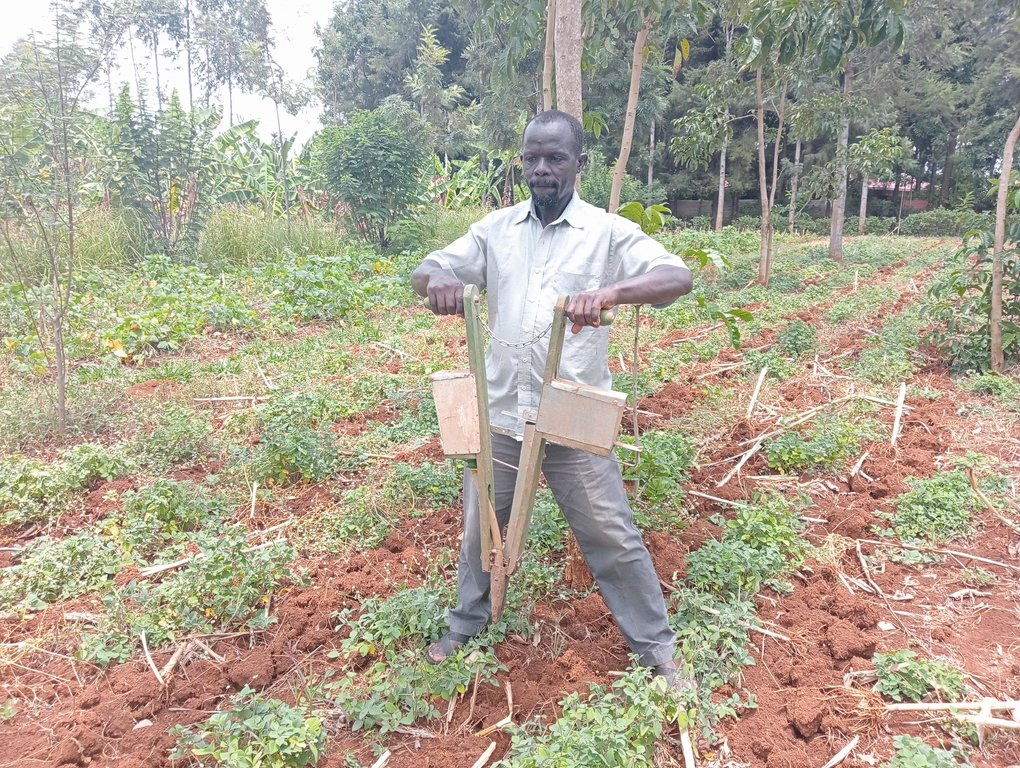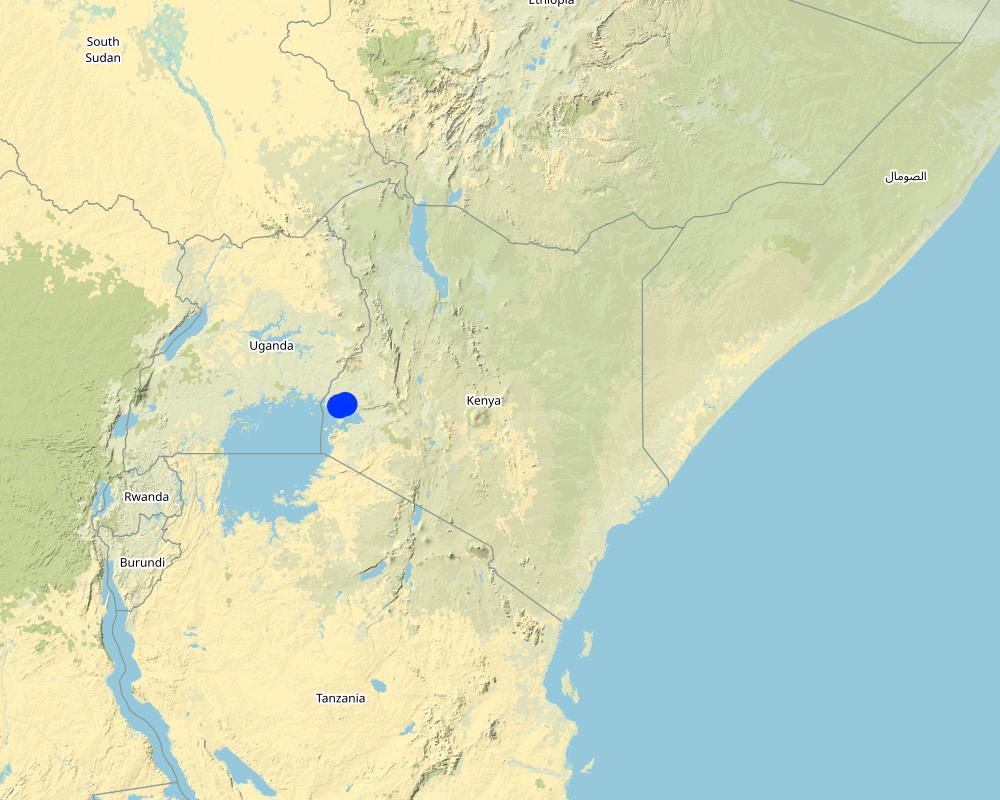Improving farmers' access to tools for conservation agriculture [Kenya]
- Creation:
- Update:
- Compiler: William Akwanyi
- Editors: Christopher Nyakan, Christopher Nyakan, Innocent Faith, Noel Templer
- Reviewers: William Critchley, Rima Mekdaschi Studer
Kuendeleza kilimo hifadhi
approaches_6738 - Kenya
View sections
Expand all Collapse all1. General information
1.2 Contact details of resource persons and institutions involved in the assessment and documentation of the Approach
Key resource person(s)
land user:
Ong'anda William Ouma
+254 722 236015 / +254 733 529508
GFA farmer
William Ong'anda's farm in Umoyo Village, Gem North Ward, Gem Yala Sub-county, in Siaya County
Kenya
SLM specialist:
Opiyo Elizaphat
+254 718 288816
opiyoelizaphat@gmail.com
Rural Energy and Food Security Organization (REFSO)
Kenya
SLM specialist:
Khasakhala Eboche Dave
+254 721 569842
khasakhalaedo@yahoo.com
Agricultural Technology Development Centre (ATDC), Siaya
Agricultural Technology Development Centre (ATDC), Siaya
Kenya
SLM specialist:
SLM specialist:
Name of project which facilitated the documentation/ evaluation of the Approach (if relevant)
Soil protection and rehabilitation for food security (ProSo(i)l)Name of the institution(s) which facilitated the documentation/ evaluation of the Approach (if relevant)
Deutsche Gesellschaft für Internationale Zusammenarbeit (GIZ)Name of the institution(s) which facilitated the documentation/ evaluation of the Approach (if relevant)
Alliance Bioversity and International Center for Tropical Agriculture (Alliance Bioversity-CIAT) - Kenya1.3 Conditions regarding the use of data documented through WOCAT
When were the data compiled (in the field)?
11/03/2023
The compiler and key resource person(s) accept the conditions regarding the use of data documented through WOCAT:
Ja
1.4 Reference(s) to Questionnaire(s) on SLM Technologies
2. Description of the SLM Approach
2.1 Short description of the Approach
Improving farmers' access to minimum tillage tools is an approach to increasing the adoption of conservation agriculture (CA) through linking them to institutions that fabricate the tools.
2.2 Detailed description of the Approach
Detailed description of the Approach:
Using minimum tillage tools in land preparation, planting, and weed management helps to achieve the principle of minimal soil disturbance in conservation agriculture (CA). However, one of the main challenges facing the adoption of minimum tillage is the high cost of minimum tillage tools. In this approach, the ProSoil project sought to overcome the challenges of accessibility to and high cost of minimum tillage tools. GIZ through Gesellschaft für Agrarprojekte in Übersee (GFA) collaborated with the County Departments of Agriculture’s Agricultural Technology Development Centers (ATDCs) to train local artisans (welders) on how to fabricate minimum tillage tools at reduced cost and ensure easy access. Currently, the farmers can order hand-held minimum tillage tools such as jab planters, hand-held scrapers, shallow weeders, hand-held subsoilers, animal draft power (ADP) subsoilers, ADP rippers, and chaka hoes from ATDCs and local fabricators at reduced costs. In addition, farmers with large pieces of land can hire heavy minimum tillage implements from ATDCs at affordable rents. The project has also partnered with the Kenya Agricultural and Livestock Research Organization (KALRO) to ensure continuous research on the minimum tillage tools and how to improve them based on the different farm settings.
To increase knowledge about minimum tillage, GFA facilitated local community-based organizations to train farmers on the importance of minimum tillage and how to use minimum tillage tools. In Gem Yala area of Siaya County, Kenya, GFA partnered with Rural Energy and Food Security Organization (REFSO) to offer these pieces of training to the farmers through their groups and link them to local manufacturers. Each group consisted of about 25 farmers of which at least 30% were women. The trainings take place at designated venues in localities that are easily accessible by farmers from different locations.
Farmers like this approach because they have been linked to the manufacturers of the tools and have had their capacity built on how to use the tools. They are therefore able to access the tools easily and at affordable prices. They are also motivated to adopt minimum tillage after having benchmarked in other farms are seen how minimum tillage has improved production.
2.3 Photos of the Approach
2.4 Videos of the Approach
Comments, short description:
A farmer demonstrating how to use a chaka hoe
https://www.youtube.com/watch?v=LMgULi30Jso&ab_channel=WilliamOnura
Date:
11/03/2023
Location:
William Ong'anda's farm in Umoyo Village, Gem North Ward, Gem Yala Sub-county, in Siaya County
Name of videographer:
William Onura
Comments, short description:
A farmer demonstrating how to use a jab planter
https://www.youtube.com/watch?v=1bxoc5IL_pM&ab_channel=WilliamOnura
Date:
11/03/2023
Location:
William Ong'anda's farm in Umoyo Village, Gem North Ward, Gem Yala Sub-county, in Siaya County
Name of videographer:
William Onura
Comments, short description:
A farmer demonstrating how to use a shallow weeder
https://www.youtube.com/watch?v=HMFrEybintM&ab_channel=WilliamOnura
Date:
11/03/2023
Location:
William Ong'anda's farm in Umoyo Village, Gem North Ward, Gem Yala Sub-county, in Siaya County
Name of videographer:
William Onura
2.5 Country/ region/ locations where the Approach has been applied
Country:
Kenya
Region/ State/ Province:
Siaya County, Nyanza Region
Further specification of location:
Gem North Ward in Gem Yala Sub-county
Map
×2.6 Dates of initiation and termination of the Approach
Indicate year of initiation:
2020
Comments:
The approach is still in use.
2.7 Type of Approach
- project/ programme based
2.8 Main aims/ objectives of the Approach
Aim: To increase the adoption of conservation agriculture (CA).
Objective: To improve farmers' access to minimum tillage tools.
2.9 Conditions enabling or hindering implementation of the Technology/ Technologies applied under the Approach
social/ cultural/ religious norms and values
- enabling
Most farmers have accepted the technology.
availability/ access to financial resources and services
- enabling
Less capital investments in maintaining the technologies under the approach.
collaboration/ coordination of actors
- enabling
Collaboration with Kenya Agricultural, Livestock Research Organisation (KALRO) and Agricultural Technology and Development Centres (ATDC), local artisans, farmer groups, and Rural Energy and Food Security Organization (REFSO) in tool production and training.
knowledge about SLM, access to technical support
- enabling
Working together with partners from the county department of agriculture to increase awareness about the tools.
- hindering
Not preferred by farmer who want to have benefits in the short term.
workload, availability of manpower
- enabling
Reduced workload in the long run.
3. Participation and roles of stakeholders involved
3.1 Stakeholders involved in the Approach and their roles
- local land users/ local communities
Farmers - men, women, and youth.
Targeted by the technologies and implement them.
- community-based organizations
Umoya Farmers Self-Help Group
Convening farmers during trainings.
- SLM specialists/ agricultural advisers
SLM specialists from the ProSoil project, Rural Energy and Food Security Organization (REFSO) and the Agricultural Technology Development Centre (ATDC).
Technical support and advisories to farmers i.e., pass the SLM knowledge to the community resource persons in the community.
- researchers
Kenya Agricultural and Livestock Research Organization (KALRO)
Continuous research on the CA tools and how to improve them based on the different settings.
- private sector
Rural Energy and Food Security Organization (REFSO)
Worked hand-in-hand with other SLM specialists to pass the SLM knowledge to the farmers.
- local government
Agricultural extension officers from the county government department of agriculture i.e., the Agricultural Technology Development Centre (ATDC).
Worked hand-in-hand with other SLM specialists to pass the SLM knowledge to the farmers.
- international organization
GIZ
Proposal design and financial support to the implementation of the approach.
If several stakeholders were involved, indicate lead agency:
GIZ
3.2 Involvement of local land users/ local communities in the different phases of the Approach
| Involvement of local land users/ local communities | Specify who was involved and describe activities | |
|---|---|---|
| initiation/ motivation | passive | Farmers in the community, targeted by the SLM technologies under the approach and awareness on access to the minimum tillage tools. |
| planning | interactive | Agricultural Technology Development Centre (ATDC) and Rural Energy and Food Security Organization (REFSO) jointly agree with farmers on when to engage each other, especially time and venue for training and awareness creation on access to tools. |
| implementation | self-mobilization | Once trained, farmers implement the SLM technologies on their own, but may seek further advice from the SLM specialists where necessary. |
| monitoring/ evaluation | passive | The planning for and conduct of monitoring and/ or evaluation is a role of GIZ and WHH. Farmers are mainly interviewed based on pre-determined questions. |
| Research | interactive | Continued research by ATDC and KALRO in consultation with farmers to develop tools that are suitable for different settings/ farmlands. |
3.3 Flow chart (if available)
Description:
The ProSoil (GIZ and WHH) provides financial support for research by the Kenya Agricultural and Livestock Researchj Organization (KALRO) and for training of farmers by Rural Energy and Food Security Organization (REFSO) and of local artisans by the Agricultural Technology Development Centre (ATDC). Umoya Farmers Self-Help Group convenes farmers for training.
Author:
William Akwanyi
3.4 Decision-making on the selection of SLM Technology/ Technologies
Specify who decided on the selection of the Technology/ Technologies to be implemented:
- all relevant actors, as part of a participatory approach
Explain:
Decisions on what SLM technologies to implement were made mainly by most partners i.e., GIZ, GFA, KALRO, ATDC, REFSO, and the farmers.
Specify on what basis decisions were made:
- evaluation of well-documented SLM knowledge (evidence-based decision-making)
- research findings
4. Technical support, capacity building, and knowledge management
4.1 Capacity building/ training
Was training provided to land users/ other stakeholders?
Ja
Specify who was trained:
- land users
- field staff/ advisers
- Local artisans
If relevant, specify gender, age, status, ethnicity, etc.
Farmers in their groups (Umoya Farmers Self-Help Group), about 25 farmers in a group, and at least 30% of the number were women.
Form of training:
- on-the-job
- farmer-to-farmer
- demonstration areas
Subjects covered:
1. Benefits of conservation agriculture - minimum tillage
2. Different types of minimum tillage tools
3. How to use different minimum tillage tools
4. Linkage to minimum tillage tools fabricators
4.2 Advisory service
Do land users have access to an advisory service?
Ja
Specify whether advisory service is provided:
- on land users' fields
- at permanent centres
Describe/ comments:
SLM specialists advise farmers at their farms whenever they visit them. Farmers can also visit ATDC, KALRO, and REFSO offices for advice. Farmers are also trained at designated venues in groups.
4.3 Institution strengthening (organizational development)
Have institutions been established or strengthened through the Approach?
- yes, moderately
Specify the level(s) at which institutions have been strengthened or established:
- local
Describe institution, roles and responsibilities, members, etc.
About 10 REFSO SLM specialists have been capacity built/ trained.
Specify type of support:
- capacity building/ training
Give further details:
Training on CA, its benefits, and how and where to access CA tools.
4.4 Monitoring and evaluation
Is monitoring and evaluation part of the Approach?
Ja
Comments:
GIZ and GFA regularly follows up with local artisans and the Agricultural Technology Development Centre (ATDC) to check on the number of farmers who have bought/ access minimum tillage tools.
If yes, is this documentation intended to be used for monitoring and evaluation?
Nee
Comments:
This documentation in intended for keeping a record of SLM technologies and approaches.
4.5 Research
Was research part of the Approach?
Ja
- Tool suitability
Give further details and indicate who did the research:
Research was done by the Agricultural Technology Development Centre (ATDC) and the Kenya Agricultural and Livestock Research Organization (KALRO) to determine which minimum tillage tools are suitable for which farm settings.
5. Financing and external material support
5.1 Annual budget for the SLM component of the Approach
If precise annual budget is not known, indicate range:
- 100,000-1,000,000
Comments (e.g. main sources of funding/ major donors):
Training costs met by GIZ ProSoil project. The cost covers training of a group of about 25 farmers and a group of about 20 local fabricators, and research in tool suitability.
5.2 Financial/ material support provided to land users
Did land users receive financial/ material support for implementing the Technology/ Technologies?
Ja
If yes, specify type(s) of support, conditions, and provider(s):
GIZ through GFA supported farmers in their groups with minimum tillage tools for demonstration purposes.
5.3 Subsidies for specific inputs (including labour)
- equipment
| Specify which inputs were subsidised | To which extent | Specify subsidies |
|---|---|---|
| tools | fully financed | GIZ through GFA supported farmers in their groups with CA tools for demonstration purposes. |
If labour by land users was a substantial input, was it:
- voluntary
Comments:
Farmers provided labour at demonstration plots.
5.4 Credit
Was credit provided under the Approach for SLM activities?
Nee
5.5 Other incentives or instruments
Were other incentives or instruments used to promote implementation of SLM Technologies?
Nee
6. Impact analysis and concluding statements
6.1 Impacts of the Approach
Did the Approach empower local land users, improve stakeholder participation?
- No
- Yes, little
- Yes, moderately
- Yes, greatly
Farmers have been empowered with skills on how to use minimum tillage tools and where and how to access them.
Did the Approach enable evidence-based decision-making?
- No
- Yes, little
- Yes, moderately
- Yes, greatly
Demonstration/ learning plots were important in enabling farmers to learn from the practitioners and from each other based on evidence.
Did the Approach help land users to implement and maintain SLM Technologies?
- No
- Yes, little
- Yes, moderately
- Yes, greatly
Farmer were trained on minimum tillage.
Did the Approach improve coordination and cost-effective implementation of SLM?
- No
- Yes, little
- Yes, moderately
- Yes, greatly
The Agriculture Technology Development Centre (ATDC) trained local artisans on how to fabricate minimum tillage tools and sells them to farmers at a lower price than that in the other farmers' shops.
Did the Approach improve knowledge and capacities of land users to implement SLM?
- No
- Yes, little
- Yes, moderately
- Yes, greatly
Farmer were taken through pieces of trainings on how to use the minimum tillage tools.
Did the Approach improve knowledge and capacities of other stakeholders?
- No
- Yes, little
- Yes, moderately
- Yes, greatly
Local artisans were trained on how to fabricate minimum tillage tools.
Did the Approach build/ strengthen institutions, collaboration between stakeholders?
- No
- Yes, little
- Yes, moderately
- Yes, greatly
Collaboration between farmers and public extension officers i.e., Agriculture Technology Development Centre (ATDC) SLM specialists. More farmers are consulting these officers for advice.
Did the Approach empower socially and economically disadvantaged groups?
- No
- Yes, little
- Yes, moderately
- Yes, greatly
The minimum tillage tools provided to the farmers in their groups are used by farmers who cannot afford to buy the tools.
Did the Approach lead to employment, income opportunities?
- No
- Yes, little
- Yes, moderately
- Yes, greatly
More local artisans were trained on the fabrication of minimum tillage tools. They sell these tools to farmers and earn income.
6.2 Main motivation of land users to implement SLM
- increased production
Increased crop yields in the long run.
- increased profit(ability), improved cost-benefit-ratio
High yields but less costs incurred on inputs and land preparation.
- reduced land degradation
Minimum tillage minimizes soil disturbance and reduces risks of exposure to agents of erosion.
- reduced workload
Promotes minimum tillage; hence, reduced need to plough the land.
- enhanced SLM knowledge and skills
Empowered farmers with skills for minimum tillage.
6.3 Sustainability of Approach activities
Can the land users sustain what has been implemented through the Approach (without external support)?
- yes
If yes, describe how:
The tools are fabricated and sold to farmers at lower prices than conventional prices i.e., prices in other shops.
6.4 Strengths/ advantages of the Approach
| Strengths/ advantages/ opportunities in the land user’s view |
|---|
| Increased access to minimum tillage tools. |
| The tools are fabricated and sold at lower prices than the prices in other shops. |
| Strengths/ advantages/ opportunities in the compiler’s or other key resource person’s view |
|---|
| The ProSoil has linked farmers to local fabricators to ensure ease of access to tools. |
6.5 Weaknesses/ disadvantages of the Approach and ways of overcoming them
| Weaknesses/ disadvantages/ risks in the land user’s view | How can they be overcome? |
|---|---|
| Very few artisans fabricate minimum tillage tools. | Training of more local artisans on how to fabricate the tools and set up businesses. |
| Weaknesses/ disadvantages/ risks in the compiler’s or other key resource person’s view | How can they be overcome? |
|---|---|
| Inaccessibility of the tools. | Increase awareness among the local artisans so that they can fabricate the tools and set up businesses and provide more affordable solution to farmers. |
7. References and links
7.1 Methods/ sources of information
- field visits, field surveys
One visit at one farm. One visit at Siaya ATDC.
- interviews with land users
One farmer interviewed at his farm. Follow-up questions on phone.
- interviews with SLM specialists/ experts
ProSoil team, project implementers from GFA, fabricators of the tools from Siaya ATDC, and SLM field support from REFSO interviewed. Follow-up consultation on phone.
- compilation from reports and other existing documentation
At least two online documents reviewed.
7.2 References to available publications
Title, author, year, ISBN:
Conservation Agriculture Technical Manual by SUSTAINET E.A.
Available from where? Costs?
Free download at https://www.weadapt.org/sites/weadapt.org/files/legacy-new/knowledge-base/files/1051/507bcb0bb6e92technical-manual-on-conservation-agriculture-sustanet.pdf
7.3 Links to relevant information which is available online
Title/ description:
Conservation agriculture
URL:
https://infonet-biovision.org/EnvironmentalHealth/Conservation-agriculture
Links and modules
Expand all Collapse allLinks
No links
Modules
No modules






